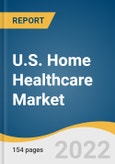The U.S. home healthcare market size is expected to reach USD 253.4 billion by 2030, expanding at a CAGR of 7.48%. The growing incidences of chronic conditions such as diabetes, cancer, and cardiovascular diseases, and the rising geriatric population is expected to fuel the market over the next few years. As patients prefer to stay at home due to reduced cost of care, as compared to a healthcare facility, the disease prevalence positively impacts the demand for home healthcare services and equipment.
Consumers’ response to home healthcare equipment and services has been positive due to benefits such as reduced cost and receiving care in the comfort of a home. Monitoring of health at home provides patients’ families and healthcare providers with real-time updates, enabling them to plan healthcare interventions.
The onset of the COVID-19 pandemic led to initiatives by care providers to promote care at home by introducing programs such as SNF-at-home and hospital-at-home. Although the pandemic positively impacted the demand for home healthcare, it contributed to staffing challenges faced by home healthcare providers before the pandemic. Some of the contributing factors included lower wages & risk of COVID-19 infection. According to a survey by the Homecare Association of America, 77% of homecare workers did not have enough masks, creating a major safety concern.
Consumers’ response to home healthcare equipment and services has been positive due to benefits such as reduced cost and receiving care in the comfort of a home. Monitoring of health at home provides patients’ families and healthcare providers with real-time updates, enabling them to plan healthcare interventions.
The onset of the COVID-19 pandemic led to initiatives by care providers to promote care at home by introducing programs such as SNF-at-home and hospital-at-home. Although the pandemic positively impacted the demand for home healthcare, it contributed to staffing challenges faced by home healthcare providers before the pandemic. Some of the contributing factors included lower wages & risk of COVID-19 infection. According to a survey by the Homecare Association of America, 77% of homecare workers did not have enough masks, creating a major safety concern.
U.S. Home Healthcare Market Report Highlights
- In July 2022, CMS updated Medicare payment rates and policies for home healthcare providers and issued HH PPS Rate for CY 2023 Update proposed rule. The updated rule includes proposals and updates in the home infusion therapy services and the Medicare HH PPS, which includes a permanent cap of 5% on negative wage index changes for HHA
- The services segment held the largest market share in terms of revenue in 2022. However, the equipment segment is expected to register the fastest growth over the forecast period due to factors such as the growing shift from hospital to care at home, ease of treatment & diagnosis at home, and reduced costs
- Product innovation and mergers & acquisitions are some of the important strategies adopted by manufacturers. For instance, in July 2021, Amedisys announced to launch a new center to provide home healthcare services in the New York Borough of the Bronx and Westchester County, NY, expanding its presence in the home healthcare market
- There is major competition between several small & large home healthcare providers in the U.S. The launch of the Patient-Driven Groupings Model (PDGM) is benefiting the large players, however, can present certain challenges to small players leading to their exit from the market
- The home healthcare industry is witnessing rapid adoption of telehealth technologies, complemented by the COVID-19 pandemic. For instance, remote patient monitoring technologies transmit patient data to caregivers, enabling prompt medical intervention. Apart from real-time monitoring of data, these devices enable patient data collection that might help predict the need for care in advance, reducing hospital readmission
- One of the major changes witnessed by the industry is the increasing utilization of technology, such as Remote Health Monitoring (RPM) and teleconferencing with the care provider. Technology startups are launching innovative products to facilitate technology integration in-home healthcare services. In July 2021, Home Health Community Organization (HHCO) launched a technology platform to provide tools and other training resources for the skill development of its employees
Table of Contents
Chapter 1 Methodology and Scope
Chapter 2 Executive Summary
Chapter 3 U.S. Home Healthcare Service Market - Industry Outlook
Chapter 4 U.S. Home Healthcare Market: Component Analysis
Chapter 5 Competitive Landscape
List of Tables
List of Figures
Companies Mentioned
- Extendicare, Inc.
- Homecare pharmacy
- McKesson Medical-Surgical, Inc.
- NxStage Medical (Fresenius Medical Care)
- Medline Industries Inc.
- Medtronic plc
- 3M Healthcare
- Baxter International Inc.
- B. Braun Melsungen AG
- Hoffman-La Roche AG
- Becton, Dickinson and Company
- Atria Senior Living, Inc.
- Amedisys, Inc.
- Diversicare Healthcare Services, Inc.
- Brookdale Senior Living Inc.
- Kindred Healthcare, Inc.
- Sunrise Senior Living, LLC
- Genesis HealthCare
- Sonida Senior Living. (Capital Senior Living CORPORATION)
- Senior Care Center
- Home Instead, Inc.
Methodology

LOADING...
Table Information
| Report Attribute | Details |
|---|---|
| No. of Pages | 154 |
| Published | December 2022 |
| Forecast Period | 2023 - 2030 |
| Estimated Market Value ( USD | $ 152.9 Billion |
| Forecasted Market Value ( USD | $ 253.4 Billion |
| Compound Annual Growth Rate | 7.4% |
| Regions Covered | United States |
| No. of Companies Mentioned | 21 |









